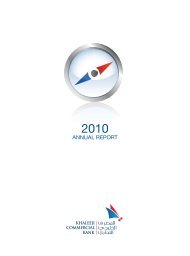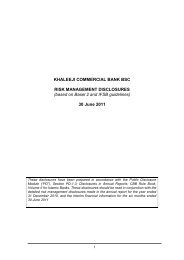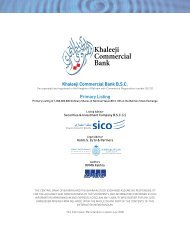2011 Annual Report - Khaleeji Commercial Bank BSC
2011 Annual Report - Khaleeji Commercial Bank BSC
2011 Annual Report - Khaleeji Commercial Bank BSC
You also want an ePaper? Increase the reach of your titles
YUMPU automatically turns print PDFs into web optimized ePapers that Google loves.
KHALEEJI COMMERCIAL BANK <strong>BSC</strong><br />
RISK MANAGEMENT DISCLOSURES<br />
6. Operational Risk (continued)<br />
6.4 Regulatory capital allocation against operational risk<br />
The <strong>Bank</strong> uses the Basic Indicator Approach (“BIA”) in calculating its regulatory capital requirement for operational risk.<br />
The risk weighted assets and capital requirement for operational risk as at 31 December is as given below (in BD 000’s):<br />
Average gross income for 3 years (A) 19,935<br />
Operational Risk Weighted Assets B = (A x 15% x 12.5) 37,378<br />
Capital requirement (B x 12%) 4,485<br />
7. Other Risks<br />
7.1 Liquidity risk<br />
Liquidity risk is the risk that the <strong>Bank</strong> will encounter difficulty in meeting its financial obligations on account of a maturity<br />
mismatch between assets and liabilities. The <strong>Bank</strong>’s approach to managing liquidity is to ensure that it will always have sufficient<br />
funds to meet its liabilities when due without incurring unacceptable losses or risking damage to the <strong>Bank</strong>’s reputation.<br />
The <strong>Bank</strong> has a liquidity risk policy in place, which describes the roles and responsibilities of the Asset Liability Management<br />
Committee (“ALCO”), Treasury and other concerned departments in management of liquidity. It also stipulates various<br />
liquidity ratios to be maintained by the bank, as well as gap limits under each time bucket of the maturity ladder. It is the <strong>Bank</strong>’s<br />
policy to keep adequate level of high quality liquid assets such as inter-bank placements, CBB sukuks to ensure that funds are<br />
available to meet maturing deposits and other liabilities, as and when they fall due.<br />
The day to day management of liquidity risk is the responsibility of the Treasury Department, which monitors the sources<br />
and maturities of assets and liabilities closely, and ensures that limits stipulated by the ALCO are complied with. RMD and<br />
Financial Control Department (“FCD”) monitors the liquidity position and any violations are reported to ALCO, ERMC and<br />
the Board of Directors.<br />
For maturity profile of assets and liabilities, please refer to note 28 of the consolidated financial statements for the year ended<br />
31 December <strong>2011</strong>.<br />
The following are the key liquidity ratios which reflect the liquidity position of the <strong>Bank</strong> (Figures in %):<br />
<strong>2011</strong> 2010 2009 2008 2007<br />
Interbank assets to interbank liabilities 218.84 113.72 137.02 436.50 190.24<br />
Liquid assets to total assets 26.04 20.81 30.02 37.04 31.63<br />
Liquid assets to total deposits 42.01 41.72 59.56 60.39 98.22<br />
Net liquid assets to total deposits 25.63 10.50 22.00 49.79 50.33<br />
7.2 Profit rate risk in the banking book<br />
The other principal risk to which the banking book is exposed is the risk of loss from fluctuations in the future cash flows or<br />
fair values of financial instrument because of a change in market profit rates. Profit rate risk is managed principally through<br />
monitoring profit rate gaps and by having pre-approved limits for re-pricing bands. The ALCO is the monitoring body for<br />
compliance with these limits and is assisted by the <strong>Bank</strong>’s Risk Management Department in its day-to-day monitoring activities.<br />
The management of profit rate risk against profit rate gap limits is supplemented by monitoring the sensitivity of the <strong>Bank</strong>’s<br />
financial assets and liabilities to various standard and non-standard profit rate scenarios. Standard scenarios that are considered<br />
on a monthly basis include a 100 basis points (bps) parallel fall or rise across all yield curves and a 50 bps rise or fall of all yield<br />
curves. An analysis of the <strong>Bank</strong>’s sensitivity to an increase or decrease in market profit rates has been disclosed in note 31 of<br />
the consolidated financial statements for the year ended 31 December <strong>2011</strong>.<br />
Risk Management Disclosures<br />
97










